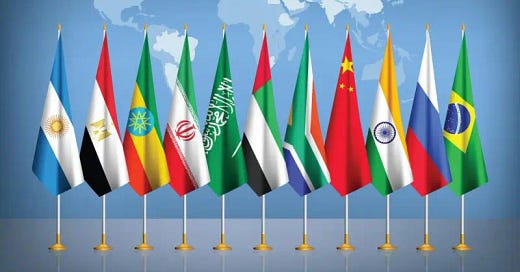BRICS Shifts From US Dominated Economic System
BRICS emulates the American System of the 19th century
I was invited to the Jay Martin Show to discuss BRICS as the primary institution facilitating a shift away from the US-led economic system. I compared the efforts of China, Russia, and other BRICS members to the American System developed by Alexander Hamilton, Henry Clay, and others, where economic sovereignty was recognized as a condition for political sovereignty.
To cement its political independence, the US recognized it could not tolerate excessive economic dependence on the British Empire. The solution was the three-pillared American System of the early 19th century, which consisted of: 1) developing a manufacturing base, 2) establishing physical connectivity through roads, ports (and later rail), and 3) creating a national bank. Other states, such as France, Germany, Japan, and Russia, began to emulate the American System in the 19th century, pursuing industrial strength as a condition for political autonomy.
After the Second World War, the US replaced the British Empire by striving for global dominance over the same three economic pillars: 1) strategic industries that create dependence, primarily high-tech and natural resources, to ensure industrial dominance, 2) physical connectivity across the world’s seas, with the US Navy controlling key maritime corridors and choke points, and 3) financial connectivity through control of major development banks, the world’s reserve currency, payment systems, and other financial networks.
China and Russia have similarly challenged US dominance by pursuing economic sovereignty as a foundation for political sovereignty. China has sought greater control over 1) strategic industries through ambitious industrial policies aimed at technological leadership, 2) physical connectivity with the Belt & Road Initiative, and 3) financial connectivity via new development banks, payment systems, and increasing trade in national currencies. Russia has similarly pursued technological sovereignty with an independent digital ecosystem, new transportation corridors such as the International North-South Transportation Corridor, an East-West corridor, and the Arctic corridor; 3) financial sovereignty with new development banks (including the Eurasian Economic Union) and de-dollarization. Other countries around the world are now following the same model.
BRICS is being developed as a multipolar model, in which US hegemony will not simply be replaced by Chinese hegemony. The objective is to transition from a unipolar or imperial system to one of multiple centers of power, in line with the Westphalian world order. In a multipolar system, any state pursuing hegemonic ambitions would see other states reducing their dependence on the belligerent power.
The global majority’s decoupling from the US and Europe reveals the mechanisms of a multipolar system, as states seek alternatives in response to attempts to sabotage China’s technological development, the theft of Russia’s sovereign funds, and the West’s increasing use of economic coercion. The US faces a dilemma: either accept a more modest role as a leading pole in a multipolar system, or attempt to sabotage this development, risking the emergence of a multipolar system opposed to US interests.
The End of US Hegemony Is Here - What Happens Next? Prof Glenn Diesen on the Jay Martin Show: https://rumble.com/v5jidi1-the-end-of-us-hegemony-is-here-what-happens-next-prof-glenn-diesen-on-the-j.html



